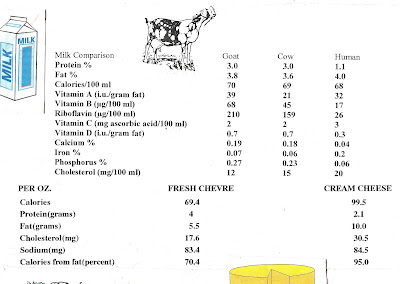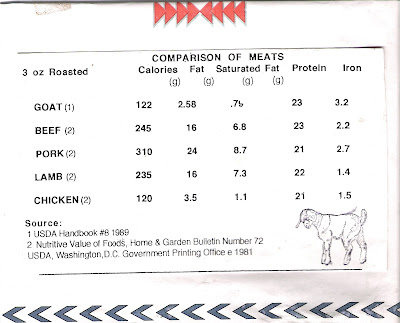Welcome to our blog. Check back often for official news and announcements from the KGBA and articles on various topics of Kinder goat care, raising, breeding, showing and more!
Blog
Milk Comparison
Comparison of Different Meats
Breeding Kinder Goats
Breeding Kinder Goats
Breeding goes hand in hand with evaluating your herd. I think there is too much voodoo written about line breeding and inbreeding. Stop thinking of breeding in human terms! Line breeding and inbreeding is very important and is done in most herds that are successfully shown, those with excellent udders, very good milk production and just general good conformation.
True that this magnifies both the bad and the good in your herd but if you have a good foundation then it is my opinion that line breeding is the only way you will continue to produce those fine animals. This is done by many breeders of all other breeds. Since the Kinder is specifically from two major breeds it is of the up most importance to do everything possible to pass these good genes on down the generation lines of the Kinder goat.
I almost shudder any more when I hear a Kinder breeder say, “Oh, I have just got to get new blood in my herd, I need something entirely unrelated to my other goats”. I have seen Kinder herds go from a top notch herd, to much lesser than in a hurry, when just adding one new herd sire.
If you have a herd that has general good conformation, that are milking well anything from 4 pounds up per day and if those animals are truly dual purpose showing a good meat carcass, then why do you want to change that? If you have sold animals to other breeders then go buy something from their lines that also has your lines in it. In this way you will be adding back some of your own genetics. If you completely cross out of your line it is hard telling what you might get. Genetics is a wild and wonderful world and we as Kinder breeders by breeding 50/50 are trying to fool mother nature into producing a goat that will continue to produces animals that conforms to our breed standards.
Look at the little doe below. Does she have a capacious udder? Some on our face book page think so. This little doe is a product of line breeding and she is lovely. God willing in a year or so I will tell you how she milks. She comes from generations of milking lines and Grand Champions.
Breeding Kinder goats is so exciting.
Evaluation of Ebony

Here is the evaluation sheet of Ebony the doe who is pictured below. A 1 is excellent, a 2 is good and a 3 is poor. You can see the score given for each different part of the body then all these scores are added together to get her final score that you see at the bottom of the page with a notation of Ex.(excellent) and signed by Harvey.
Clicking on the evaluation sheet will make it easier to read.
Ebony
Thoughts
We are coming to the close of Evaluate Your Own Goat, there are a few things that I need to mention in regard to breeding the best possible Kinder goat.
You want to breed for that big robust animal with a huge front end and lots of extension of brisket. You want the fleshing over the shoulders. You want those big necks that blend into those shoulders.
You want that animal to have a smooth and level top line that begins at the neck and goes all the way to the tail.
You want a rump that is not sloping. You want an udder that is high and tight. You want capacity in that udder, not an udder the size of a grapefruit. You want an udder that fills that escutcheon area. This what they mean when they mention the capacity of udder. You must have that capacity of udder to get a good volume of milk per day.
Care needs to be taken not to breed an animal that is too tall. We do not want to breed just another dairy animal we are breeding a dual purpose animal. Maximun height at the withers is 26 inches for does and 28 for bucks. If you don’t where the withers are on your goat then click on Older Post and find the illustration showing the parts of a Kinder goat. Take a yardstick and measure at the withers.
Don’t just buy a buck, be very critical when buying or using a herd sire. Look at his dams udder, ask how much she milks. If possible ask to milk her to see the ease of milking. Look at the overall conformation of the dam. Once again watch that rump! That buck is more than 50% of your herd so pay very close attention to him.
Disclaimer: The opinions, views, and thoughts expressed by newsletter and blog contributors do not necessarily reflect those of the Kinder® Goat Breeders Association. Goat husbandry advice found in the newsletter and blog is not meant to substitute a valid veterinary relationship. Please request permission to share or reprint newsletter and blog posts.


